A budding canopy of lush, tightly clustered cannabis plants flourishes before you, prospering under the grow room’s LED lights. The yield is impressive, abundant, and the plant health is unsurpassed. This is made possible by a specialized growing technique called the sea of green.
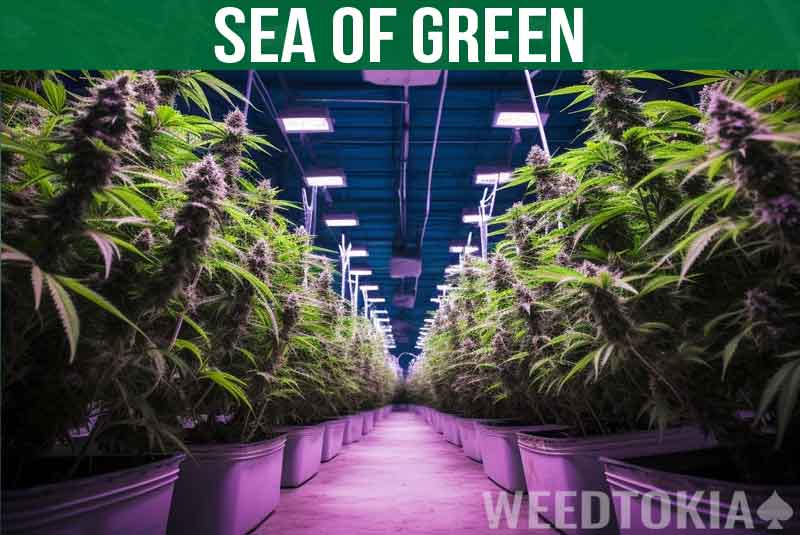
The goal of SOG is to maximize crop yield in a limited space while maintaining bud quality and equalizing plant health and vigor. Plants hit the flowering phase earlier with a shorter vegetative stage, increasing the number of harvests per year.
The major benefit is accelerated bud development and achieving large yields as fast as possible. Sounds like every grower’s dream, right? When executed correctly, the results can be amazing.
What is the Sea of Green Method?
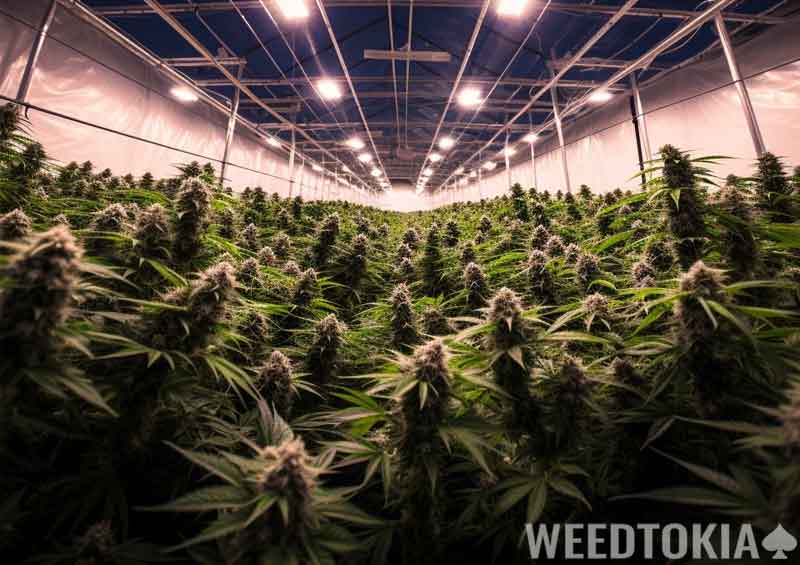
The sea of green method (also known as “SOG”) is an indoor cultivation technique that manipulates a large cluster of cannabis plants to grow at the same height rather than allowing the plants to exhibit their natural growth habit.
The plant structure is pruned and trained to fill the canopy into a hedge-like formation or “sea” (hence the name). Growers can expect yields of up to 50-75g per plant using the SOG method.
Sea of Green (SOG) Benefits
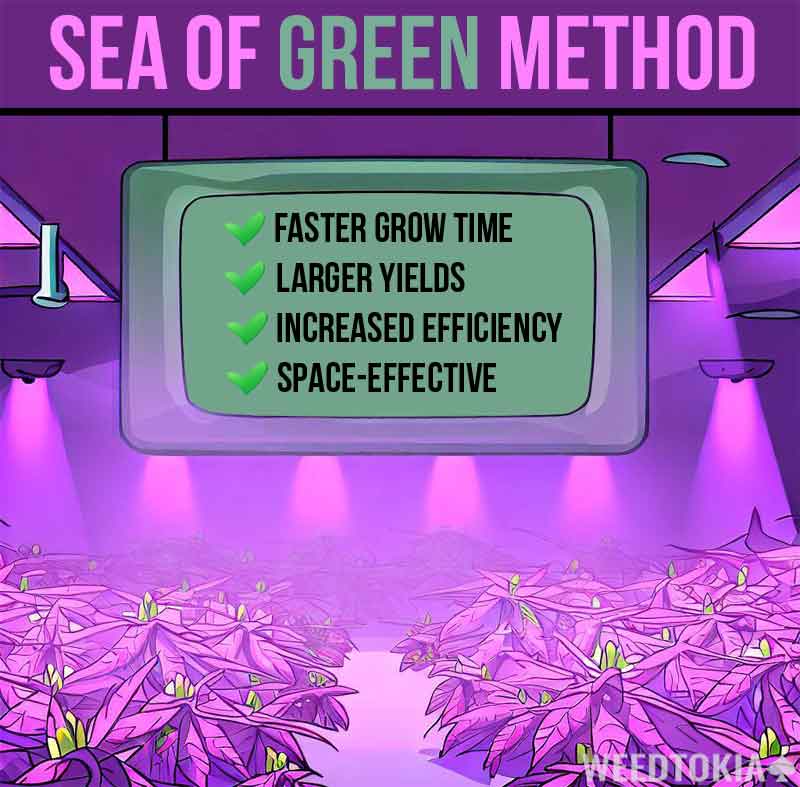
1. Faster Grow Time
A cannabis plant can take up to 6 months to grow in nature. Using the SOG method, the plant can grow in as little as 1-4 months. After it’s fully grown, you can harvest multiple times a year. This is because the plants are given optimal growth conditions.
For example, a hybrid plant like OG Kush might take up to 10 weeks to grow fully in natural conditions when it’s not receiving sunlight 24/7. It can grow in less than 8 weeks in a SOG grow room. The growth time is effectively shortened for every strain.
When you shorten the growth time, you reach the vegetative stage and harvest faster. Your bottom-line profits increase significantly because you can pick the flower faster.
It’s definitely worth investing more in a large grow space for your plants where you can use the SOG to plant hundreds of them at a time. You could also do this at home in a smaller room and grow your plants faster.
2. Larger Yields
Yields produce profits, and you need high-yielding plants to be a successful grower. A single OG Kush plant will give you about 500 grams, and a single gram sells at an average of $13 at a dispensary. This means a single plant is worth $6,500 on the retail market.
If you take away your maintenance costs, you’ll still likely be in profit.
The average yield for OG Kush is 500 grams (17 oz) per square meter (10 square feet). With the SOG method, you could possibly plant hundreds of these plants next to each other and do the math on the profits.
You could even grow them at home if it’s legal in your state. If you’re 21 years old, you can grow up to 6 plants at home legally. You can pay off rent just by growing these plants at home.
For bigger players, there are licenses that amount to hundreds of thousands. But when you consider the fact that your growth time will be shortened and you can harvest the plant every 8 weeks, it’s worth it.
3. Increase Efficiency
You could save thousands of dollars on electricity bills by growing your plants up close. A large grow room might consume as much electricity as a Bitcoin mining farm because you have to keep the lights and fans running 24/7.
If your plants are stacked close to each other, you’ll be able to use less electricity to grow the plants. Why waste one grow light per plant when you can grow multiple plants under a single grow light?
Let’s say you’re restricted to a 4 x 4 foot (1.2m x 1.2m) space. Your monthly electric consumption between the grow light, cooling fan, and air pump can amount to 70-80 watts. At an average of 23 cents per watt in the US, you’re looking at a monthly cost of $16 per plant.
If you could grow 2 or 3 plants in the same space, your total maintenance cost goes down significantly. Growing your plants close together with the SOG method will allow you to save a lot of money. Don’t forget that your plants will flower faster too.
4. Space-Effective
If your horizontal space is limited, the SOG method can help you conserve space. Let’s say you’re growing plants in a Californian bedroom and you don’t have a lot of real estate to spread them out. You could grow them close together and fill up the room.
The key here is to pick the kind of strains that won’t interfere with each other’s growth and grow upwards. These are strains like OG Kush and Girl Scout Cookies (read below for details).
The benefits are also there when you have a large grow operation. Let’s say you’re growing 500 plants in your grow room, but there’s plenty of space between them. You could reseed your buckets with new seeds that are optimized for the SOG method. Instead of 500 plants, you could squeeze 800 or even 1,000 plants in the same space.
The more plants you have, the larger the yields. You’ll reap higher profits, and you’ll make efficient use of your space.
How Long Does it Take for The SOG Method to Work?
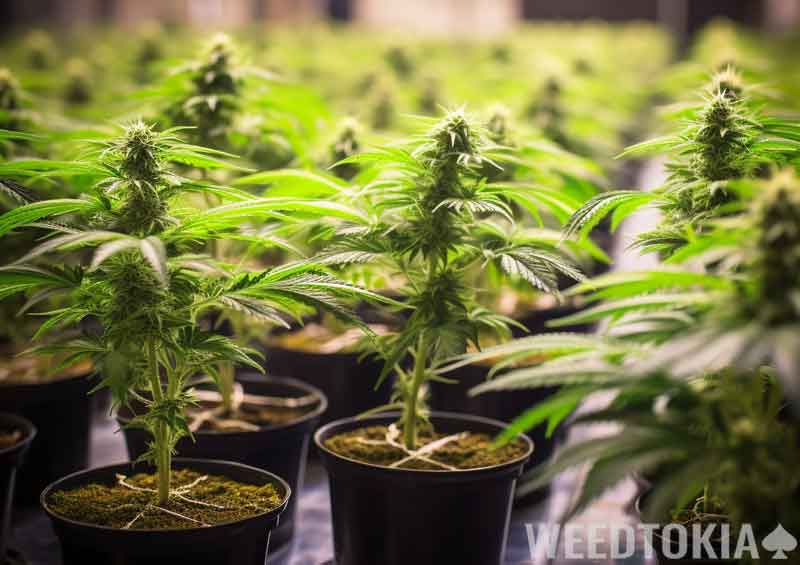
SOG has been used successfully for decades in fruit production (known as the Espalier technique), and the yields for cannabis have been just as impressive. For most cannabis cultivars, you only need about 2-4 weeks of vegetative growth to be successful with this method.
Ideal Strains for a Sea of Green Operation

SOG cannabis strains don’t interfere with other plants’ growth when they’re next to each other. This means they won’t impair the growth ability of the plant next to them.
These strains are rare, but they exist. Strains like OG Kush, Mazar, Blueberry, Northern Lights, and Girl Scout Cookies all fit the bill. You’ll want to seed your buckets with one of these strains to run a successful SOG operation.
SOG works best when utilizing plants that grow fast with minimal side branching with a compact growth habit since plants are placed close together. Hardiness, pest resistance, and fast, robust root development are also key factors to consider. For best results, it’s recommended to use strains with an Indica ratio of at least 50 percent.
The plant must be hard and resistant. If you have pests that destroy plants, you might have to re-grow your plants entirely. This can affect your bottom-line if you’re paying rent and need to keep the profit margins consistent. Stick to strains that are easy to maintain and pest-resistant.
Sativa-dominant strains may become difficult to maintain and typically create larger internodes, which is not ideal. Short Indica-dominant plants reduce pruning frequency and can also be managed in grow operations with limited ceiling height.
1. OG Kush
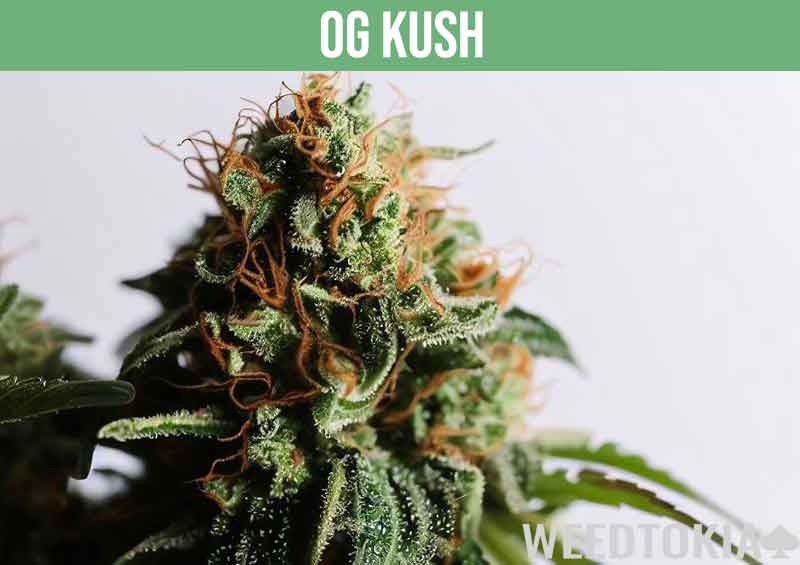
| Grow Time: | 8-9 weeks |
| Yield Per Plant: | 450-570 grams |
| Price Per Gram: | $13 in the US/€20 in the Netherlands |
| Plant Retail Value (approx.): | $6,000 |
| Water Consumption: | High |
| Harvest Frequency: | 2.5 months |
| Maximum Height: | 3-4 ft (90-120 cm) |
| Origin Location: | California, USA |
OG Kush is one of the most well-known strains in the world. The average flowering period is 8-9 weeks, so you could harvest every two and a half months on average or 4-5 times a year.
One OG Kush plant will yield 16-20 ounces (450-570 grams). If you use the SOG method, this will likely be on the upper end and exceed 500 grams per plant. I’ve known friends who grew over 570 grams at home.
It commands an expensive gram at a $13/gram average in the US and more than €20 per gram in the Netherlands. This means an average plant’s retail value is over $6,000.
The main advantage of OG Kush is its high commercial value. It’s popular in modern culture with frequent references in hip-hop music, making it desirable. Even if you don’t have a dispensary to sell your product, you could likely strike a deal with one for this strain.
2. Mazar
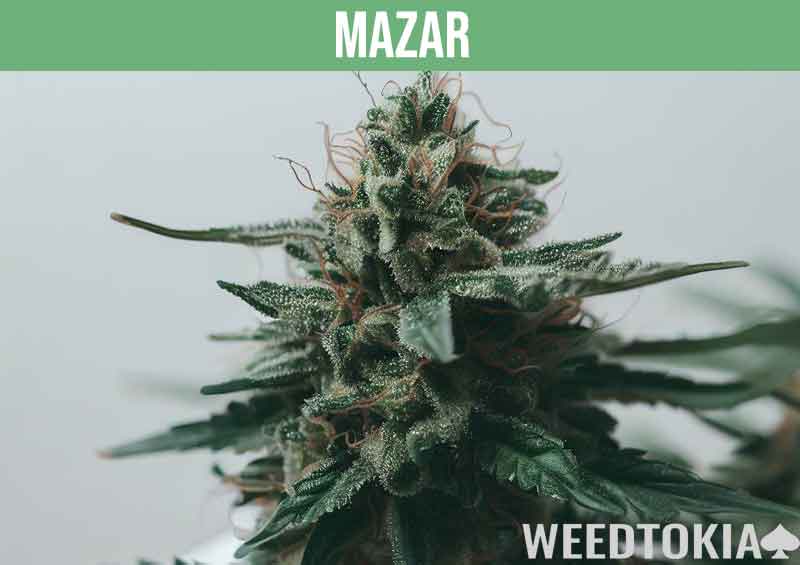
| Grow Time: | 8-9 weeks |
| Yield Per Plant: | 450-570 grams |
| Price Per Gram: | $15 per gram in the US/€20 in the Netherlands |
| Plant Retail Value (approx.): | $7,000 |
| Water Consumption: | High |
| Harvest Frequency: | 2.5 months/4 times annually |
| Maximum Height: | 3-5 ft (90-150 cm) |
| Origin Location: | Afghanistan |
Mazar is one of the oldest Indica strains, originally grown in the cold mountainous regions of Afghanistan. This is considered an “old school” plant in the 420 community, but it’s one of the optimal plants for a SOG operation.
The effects are super strong, and you enter a deep meditative state after taking a few puffs. Mazar is very similar to OG Kush in terms of the time it takes to grow, it takes 8-9 weeks on average, and you can harvest multiple times a year.
The yield per plant is also identical to OG Kush hat 16-20 ounces (450-570 grams). Using the sea of green method, your plants might yield close to 600 grams with each harvest.
Mazar is a short and bushy indica plant, so it’s perfect for growing in areas where you have restricted vertical space. A gram of Mazar in the US can cost up to $15, and it’s over €20 in the Netherlands. The average plant’s retail value is in excess of $7,000.
3. Blueberry
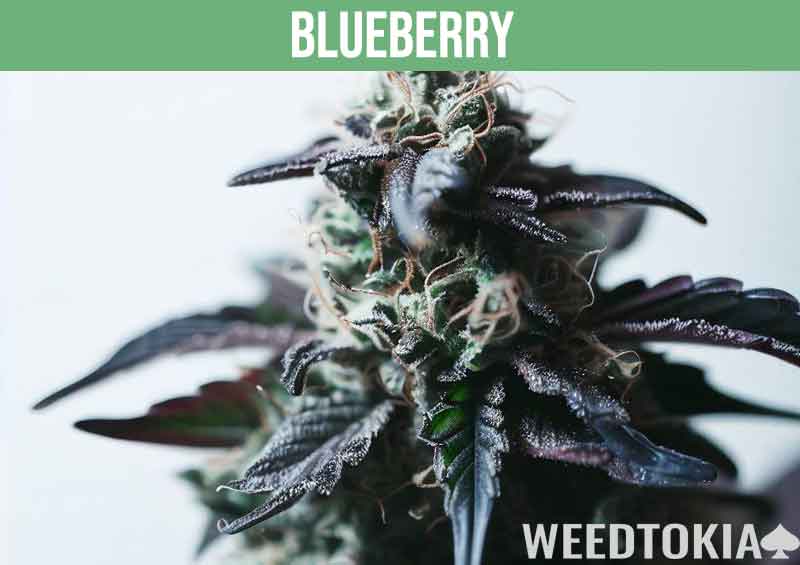
| Grow Time: | 9-10 weeks |
| Yield Per Plant: | 400-550 grams |
| Price Per Gram: | $12-16/gram in the US |
| Plant Retail Value (approx.): | $4,800-6,600 |
| Water Consumption: | Moderate |
| Harvest Frequency: | 3.5 months |
| Maximum Height: | 3-6 ft (90-180 cm) |
| Origin Location: | California, USA |
Blueberry is a relaxing hybrid strain originating from Blue Dream (50%) and Girl Scout Cookies (50%). The strain has a reputation for its arousing properties and powerful scent. It smells like blueberry fruit, so expect a fruity aroma inside your grow room which is quite pleasant.
If you’re sensitive to smells and spend a lot of time in your room, you want something that’ll smell good. Blueberry is that strain.
It’s one of the slower strains and takes 9-10 weeks to grow on average, which is a few weeks more compared to strains like OG Kush. You can possibly cut down on the grow time by 1-2 weeks with SOG.
The average price per gram in the United States will range between $12-16. With a yield of 400-550 grams per plant, your plant’s retail value will be between $4,800 and $6,600.
4. Northern Lights
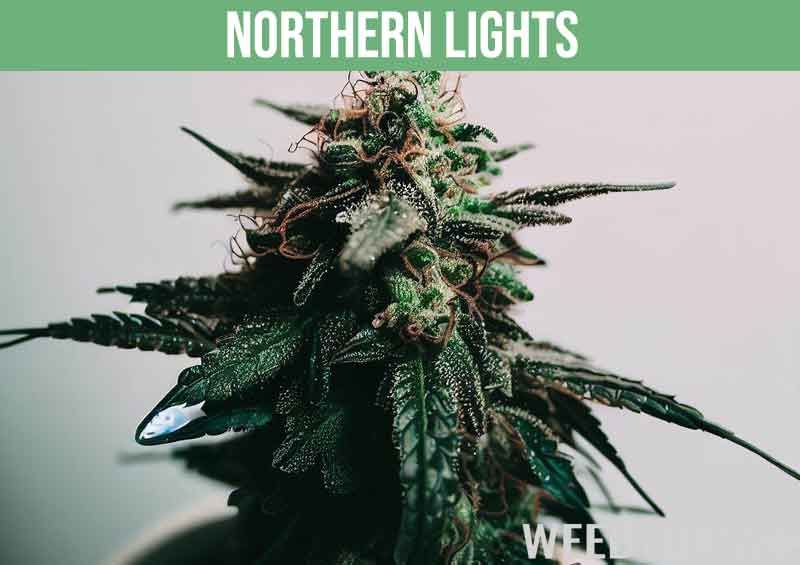
| Grow Time: | 7-8 weeks |
| Yield Per Plant: | 400-510 grams |
| Price Per Gram: | $10 |
| Plant Retail Value (approx.): | $4,000-5,100 |
| Water Consumption: | Low/moderate |
| Harvest Frequency: | 2 months |
| Maximum Height: | 3-5 ft (90-150 cm) |
| Origin Location: | Debatable: Pacific Northwest, USA or Netherlands |
Northern Lights is one of the most well-known indicas, and it has mysterious origins. Some claim it originated in the Pacific Northwest, while others say it’s from the Netherlands. The only thing that’s certain is that it will put you to sleep.
It has highly relaxing properties with a high CBD content, and it’s used as a sleep aid. This strain will always be in demand, so it’s an excellent choice for a grow room.
For growers who like to pick flowers often, this may be the best option. It has an ultra-short flowering period of 7-8 weeks, which means you can harvest every 2 months on average. The buds are thick and smell earthy.
The yields are not that impressive, and they average out at 400-510 grams per plant. The average price per gram in the US is $10, which means the retail value of a plant is between $4,000-5,100.
5. Girl Scout Cookies

| Grow Time: | 9-10 weeks |
| Yield Per Plant: | 410-500 grams |
| Price Per Gram: | $14-15/gram in the US |
| Plant Retail Value (approx.): | $6,500 |
| Water Consumption: | Moderate |
| Harvest Frequency: | 3 times a year |
| Maximum Height: | 2-4 feet (60-120 cm) |
| Origin Location: | California, USA |
Girl Scout Cookies, or GSC, is a popular strain that originated in the Bay Area of California. It’s a cross between OG Kush and Durban Poison strains. The strain is actually used in a lot of new hybrid strains and will remain popular for decades to come.
The main reason it’s a known strain is the euphoric properties. This is one of the most euphoric strains that unleashes dopamine. Once the euphoria wears off, a person feels deep relaxation.
GSC has a long flowering period at an average of 9-10 weeks. The yield per plant is also low at an average of 410-500 grams, similar to Northern Lights.
The main advantage of GSC is that it commands a high price per gram. It averages out between $14-15 per gram in the United States, and with a moderate yield average of 450 grams, the average plant would produce around $6,500.
The sea of green method has many benefits, and when executed correctly following ideal parameters, it can generate impressive yields. Always be sure to consult your local authorities and governments on legal cannabis growing limits before pursuing any growing method.
Note that you can also mix different weed strains in your grow operation. You don’t have to plant OG Kush or GSC exclusively. You can have them next to each other, and they still won’t interfere with the growth of their neighbor.
Starting Your SOG With a Mother Plant
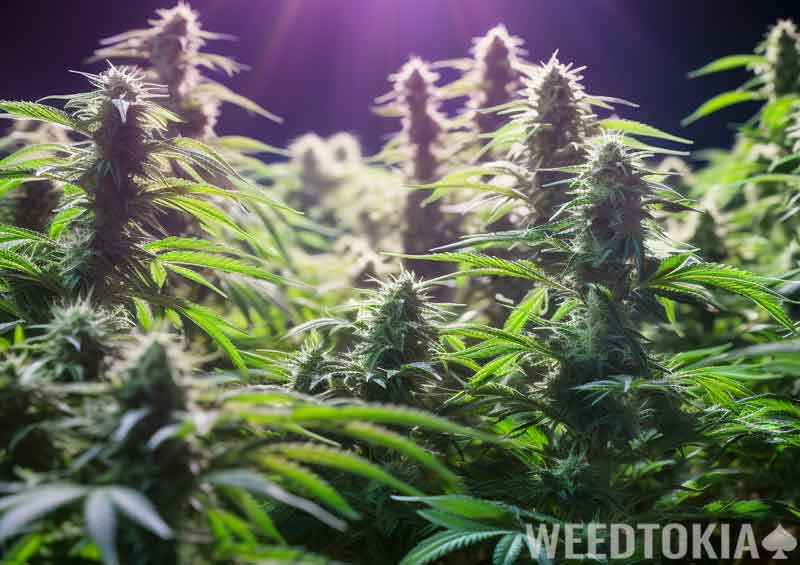
For a successful SOG, you’ll need to start your crop with healthy plants during propagation. Whether you’re growing one plant or many, it’s crucial to develop healthy plants in the propagation phase to ensure plant productivity can be maximized later on in the cycle.
For the sea of green method, we recommend cutting clones from feminized mother plants and, ideally one phenotype (one mother) or phenotypes with similar growth habits. Growing multiple strains together in a SOG crop may present challenges with targeting ideal vegetative times, pruning, feeding, and other inputs. The goal is to maximize efficiency in the canopy and eliminate as many variances as possible.
How to Select a Mother Plant for Your SOG
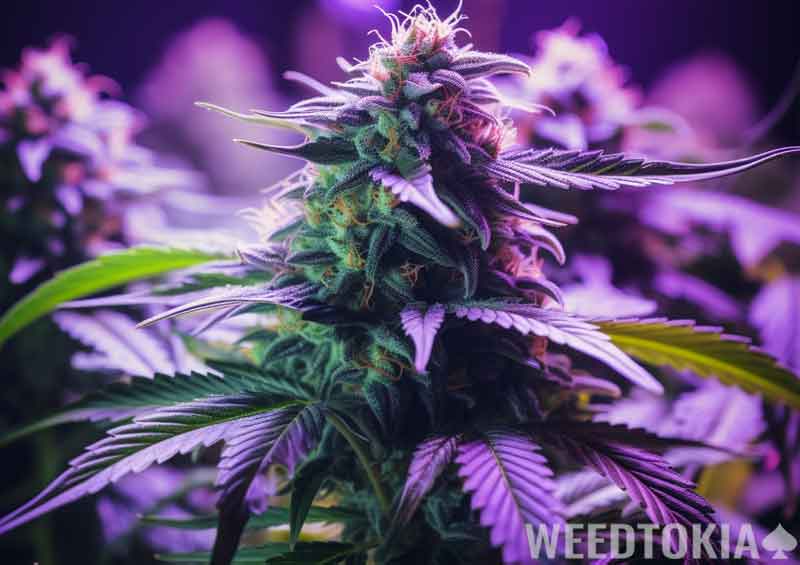
When selecting a mother plant, carefully inspect the plant for any visible diseases, molds, mildews, and pests. Any pathogens present on your mother plants are almost guaranteed to be transmitted to your clones once cut, especially diseases like powdery mildew that thrive in high-humidity environments.
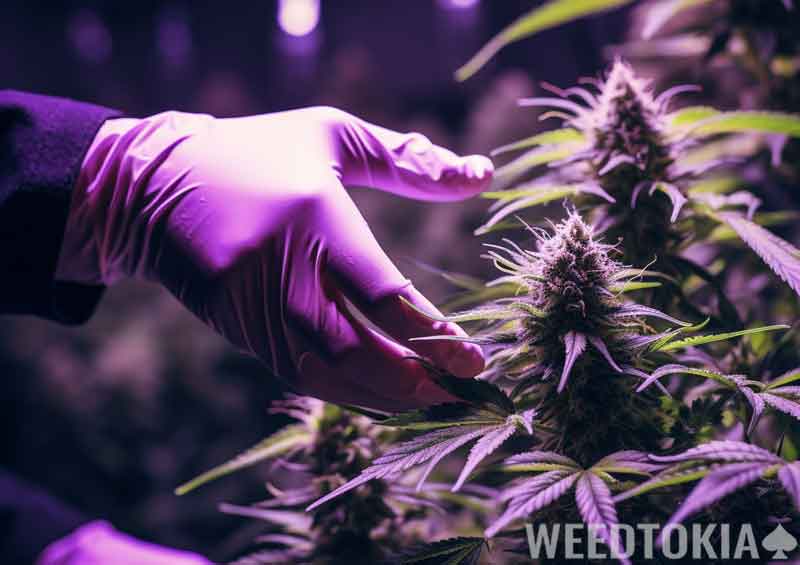
Mother plants for cutting clones should be no more than 6-8 months old. Because of the short life cycle of cannabis plants, cell division begins to slow at this point, and this slowed growth can be passed on to your clones in propagation.
It’s imperative to ensure mother plants are actively producing lush, vigorous growth points that show no signs of nutrient deficiencies or foliar pathogens.
How to Cut Your Mother Plants
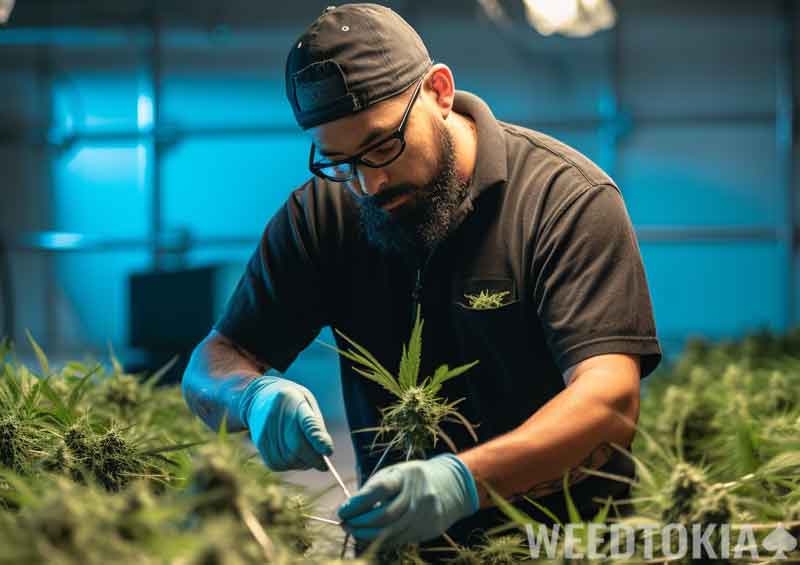
It doesn’t necessarily matter where you cut your clones from on your mother plant. However, you do not want any clones with extremely thin or “noodle-like” stems. Growth points should be approximately 2-5mm in diameter and cut 3 inches tall. We recommend starting at the top of your mother plant when cutting clones and working your way down.
The healthiest clones tend to be towards the top of the mother plants, as this is where the plant is primarily developing. This also provides a great opportunity to prune and defoliate your mother plants so they can regenerate properly for your next round of cuts. You’ll notice many growth points towards the interior of your mother plants will be underdeveloped, “noodle-like,” or even yellowing. This is due to the lack of air circulation and light in these areas and is not ideal for cutting clones.
Cut clones at a 45-degree angle at the bottom of the stem and gently scrape the outer growth layer half an inch up from this area to expose the living tissue beneath. Dip this area into growth hormone or a kelp product to promote fast root development. Once clones are placed into the substrate, ensure humidity is maintained within a propagation dome at 80-100% humidity for the first 7 days. After this point, you can slowly vent the domes and acclimatize clones for transplant.
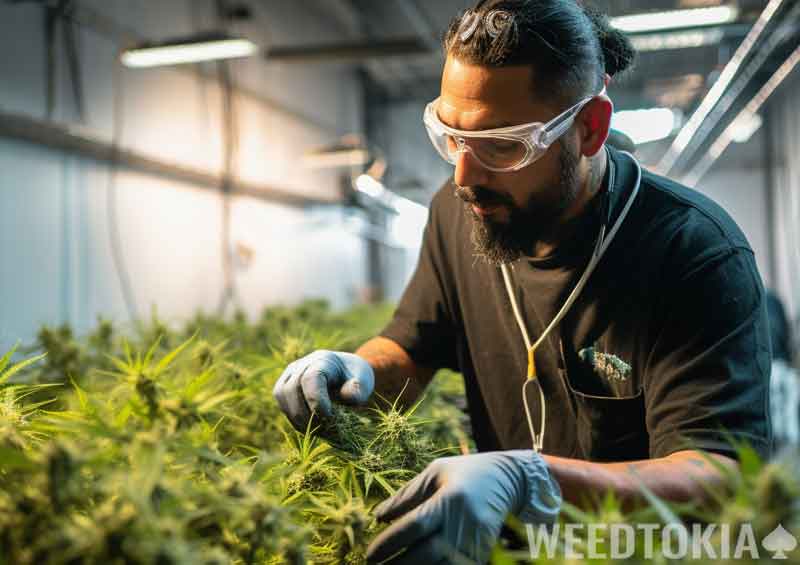
Roots should be present in the substrate for 10 to 14 days. Root development can also be tested at this time by completely removing the propagation dome from the tray. If they begin to wilt, this means there is no root development yet, and the plants are unable to transpire and maintain turgidity (stiffness) on their own.
At this time, if excessive yellowing or wilting is present, it’s likely that there is little to no root development due to rot. This may be caused by too much heat within the dome, overwatering clones, or improper ventilation of the propagation dome after the first week. “Hardening off” clones (slowly acclimatizing them) is key for proper root development and mitigating transplant shock in the early vegetative stage.
The Importance of Topping: How and When to Top Marijuana Plants
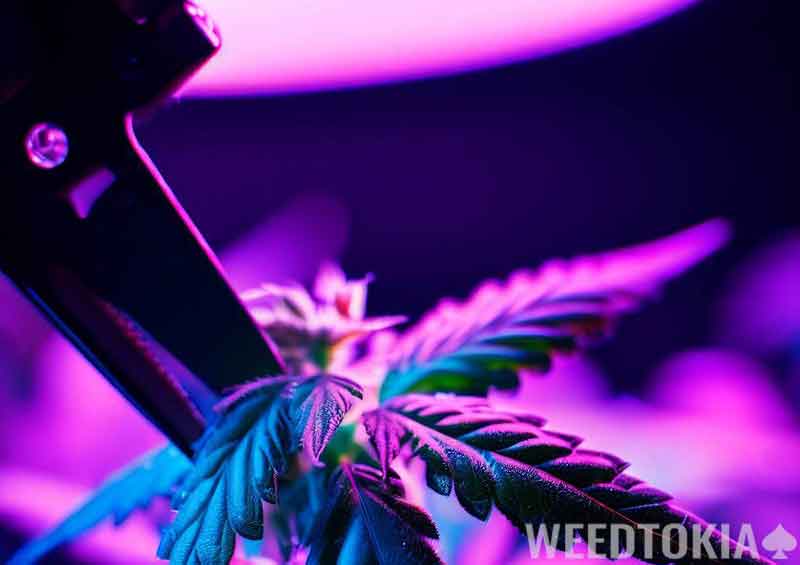
Topping is a crucial step of SOG that can’t be overlooked. To top a plant, cut off the growing tip of the main stalk of the cannabis plant to redistribute auxins (growth hormones) from the main stalk to the side branches for lateral, bushier growth. This also allows you to keep your grow lights at an equal height for all remaining growth points.
We suggest topping plants around weeks 2-3 of the vegetative stage to ensure proper internodal spacing for optimal bud development, light penetration, and air circulation. For certain cultivars, you may want to consider letting plants grow for an additional week to ensure nodal spacing does not become too compact once topped.
That said, growers need to keep a watchful eye on their crops so that they don’t allow plants to grow too much without topping, as stretching can occur and create large internodes, which can weaken the stems and reduce bud sites. Once the apical meristem or terminal growth point is removed, all remaining growth points below it will compete for apical dominance in the canopy.
This is because the highest concentration of auxins is concentrated at the apical meristem—the top node of the plant—to guide the upward growth of the plant to develop its natural habit (think of the tip of a Christmas tree). In SOG, the aim is to disrupt this natural growth and manipulate the canopy into one consistently level “sea” of growth points for the best possible light penetration and air circulation for optimal bud development and density across the canopy.
How to Properly Top Cannabis Plants
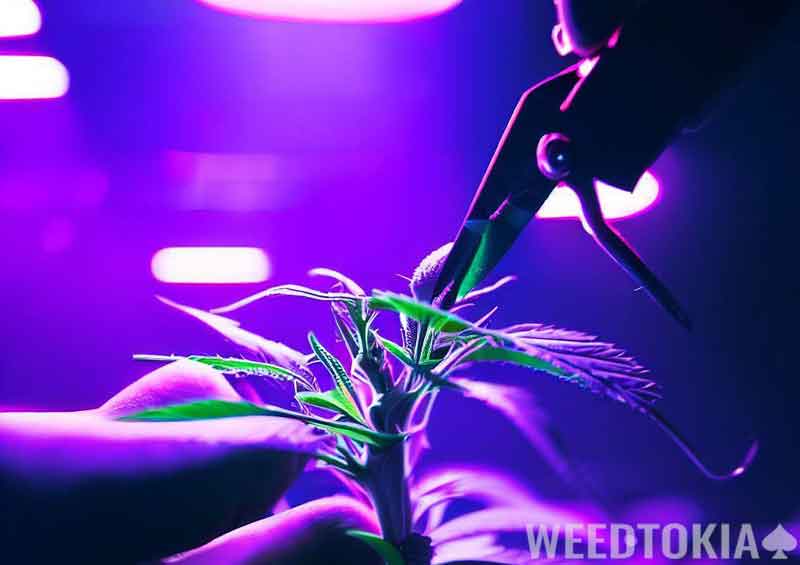
The best way to top the apical meristem of cannabis plants is to cut at a clean 45-degree angle at the bottom of the stem axis. This ensures proper tissue repair and limb development.
This may look strange at first because the new dominant point below will appear on an angle. However, a clean 45-degree angle cut will allow the tissue to repair in such a way that the new point below will eventually grow straight up.
This would not be possible if the remaining piece of the topped stem was left intact. We also suggest removing any axillary growth points at the bottom of the stems so they do not attempt to develop into “suckering” branches (AKA: branches that compete for apical dominance from deep within the canopy that reduces air circulation and bud development).
Once topped, it’s imperative that initial pruning maintenance be carried out before the flower stage to ensure proper structure and consistency across the canopy. Any pruning performed once bud development is present will result in a loss or waste of energy that could have been utilized for bud development higher up in the canopy. Cannabis plants have a relatively short life cycle, so it is important that all energy is utilized to maximize output.
Pruning vs. Weaving
Some growers may prefer to rely on “weaving” or bending branches to achieve the SOG canopy. However, this method comes with its risks. Excessive weaving of limbs can reduce circulation in the canopy, which can create a vector for bud rot and powdery mildew.
Instead, we suggest sticking to pruning and defoliating as our primary method, as it allows for more plants per light and better safeguards your crop against any issues that may arise. It’s also less likely for irreversible damage to occur to plants when performing a quick clean cut instead of bending and weaving limbs.
How Many Plants Per Light?
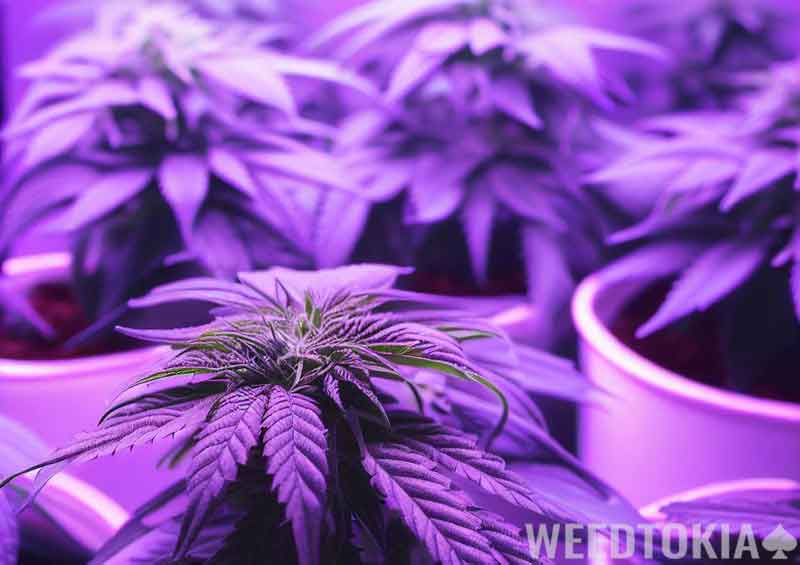
We recommend around 6-9 plants per light, depending on the cultivar’s growth habit. You may find after one round with this method that you can adjust your plant count (less or more) depending on your initial output. Regardless of your pot size, space plants about 12-16 inches apart (measured at the center of the stem).
What is the Best Lighting For SOG? LED vs. HPS
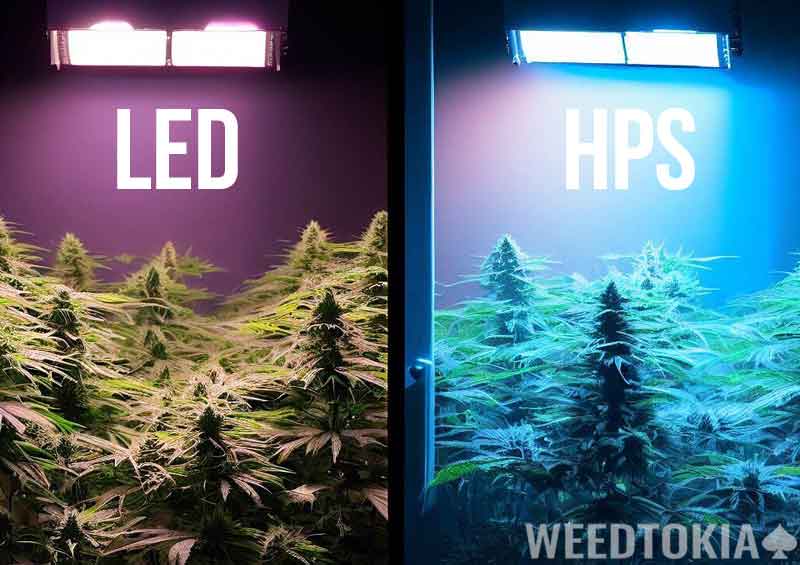
Selecting the best lighting source is a key driver in crop success. LED lights can create a very efficient SOG, while HPS bulbs may cause overcrowding and excessive elongation with many plants clustered close together. This is due to the abundance of far-red light that makes up the majority of the HPS spectrum and bolsters elongation.
LED lights contain a more diverse spectrum with more blue light, which leads to shorter, more compact plants. If you don’t have access to a quantum sensor to measure photosynthetic photon flux density (PPFD), keep your light height around 2.5 feet in the vegetative stage and 1.5 feet in the flower stage. If you see any signs of leaf scorching or bud bleaching, raise your lights 3-6 inches and continue monitoring.
How to Establish Limb Structure: Pruning, Defoliating, and Support
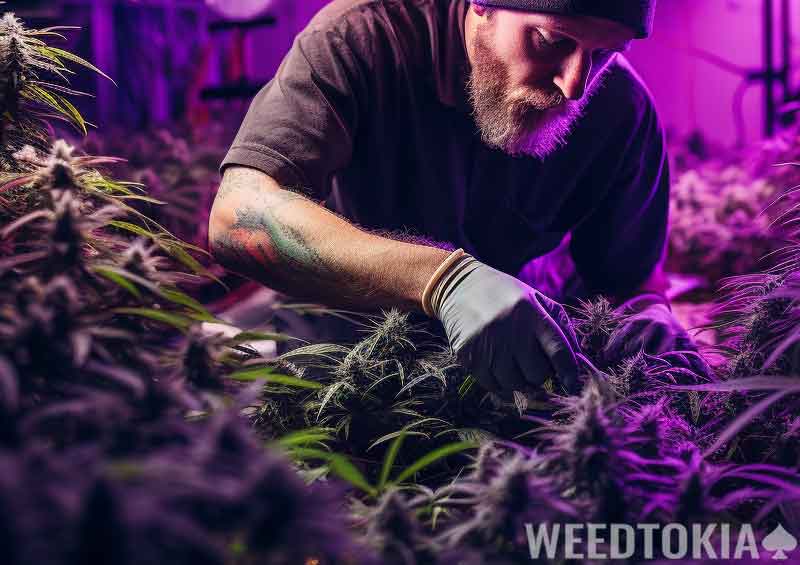
After topping, it’s important to establish proper limb structure early in the vegetative stage as it will directly impact the success of your desired canopy. Proper limb structure is achieved by pruning limbs, defoliating fan leaves, and implementing a trellis or netting for additional support.
Pruning
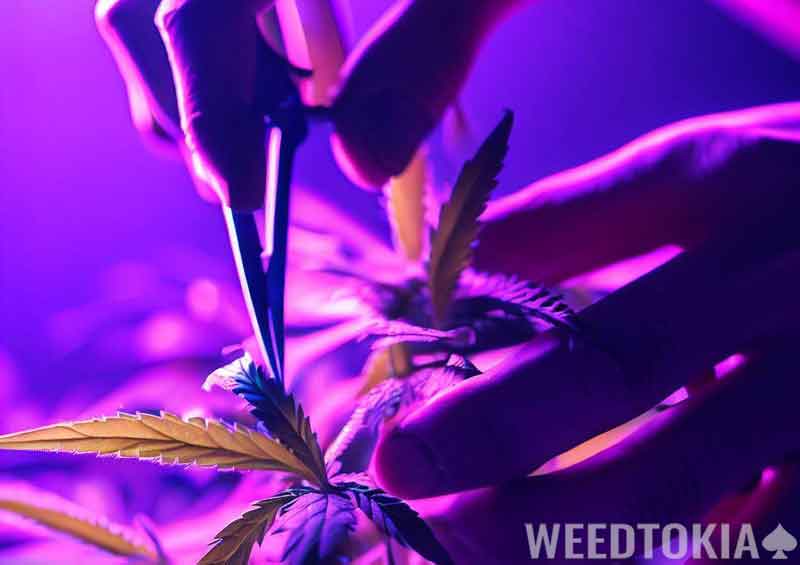
You can start pruning limbs from the bottom-up on each plant at weeks 2-3 of the vegetative stage. Pruning cannabis plants involves carefully cutting off lateral branches that are fighting to make it to the top of the canopy. These branches are prone to developing a “J” shaped structure rather than the desired 45-degree angle off the main stalk. These additional “J” shaped limbs are weak in structure and crowd the canopy, thereby reducing air circulation and light penetration to the desired growth points.
Essentially, the plant limbs need to be pruned from bottom to top until 3-5 growth points are established at the top of the canopy that will receive equal amounts of light and air circulation.
Removing these limbs also forces auxins to concentrate on fewer growth points in the flowering stage. This results in greater density and overall bud size, as opposed to having a higher number of smaller buds spread throughout the plant that runs the risk of becoming underdeveloped. It’s important you make cuts close to the end of the stem where the collar is located (bulge at the point where the stem connects to the main stalk). This area contains a high concentration of growth hormones that will stimulate faster tissue repair so the plant can make a speedy recovery and focus on bud development.
Defoliating
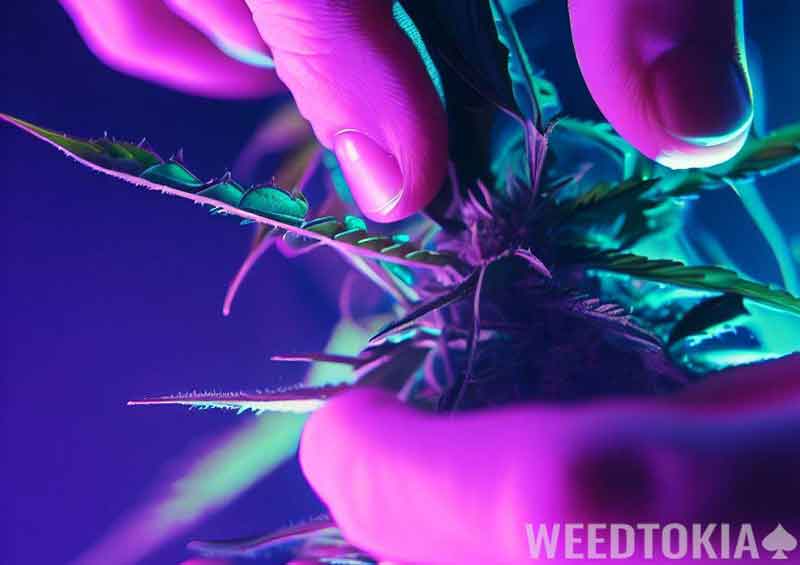
After initialing pruning is complete, you’ll need to defoliate any large fan leaves that may be challenging the newly established growth points. Look at the plant from above and remove any large fan leaves protruding from the center of the plant that are covering your three to five growth points. This step is essential to maintain the desired limb structure and canopy development.
Any fan leaves that cover the desired growth points will force the limbs to grow laterally to seek out light. This can once again create the undesirable “J” shaped limbs you want to avoid and make it difficult for these limbs to hold up large colas later in the flowering stage (the flowering top of a cannabis plant where the bud develops).
The aim is to create 3-5 alternating 45-degree branches at the top of the canopy and avoid a Menorah-like structure configuration. To illustrate the difference in strength, think about when you’re lifting dumbbells: you can hold a 5-pound weight above your head with your arm fully extended for longer than you could if your arm was held out from your side. This is the same idea.
Adding Extra Support (Trellis/Netting)
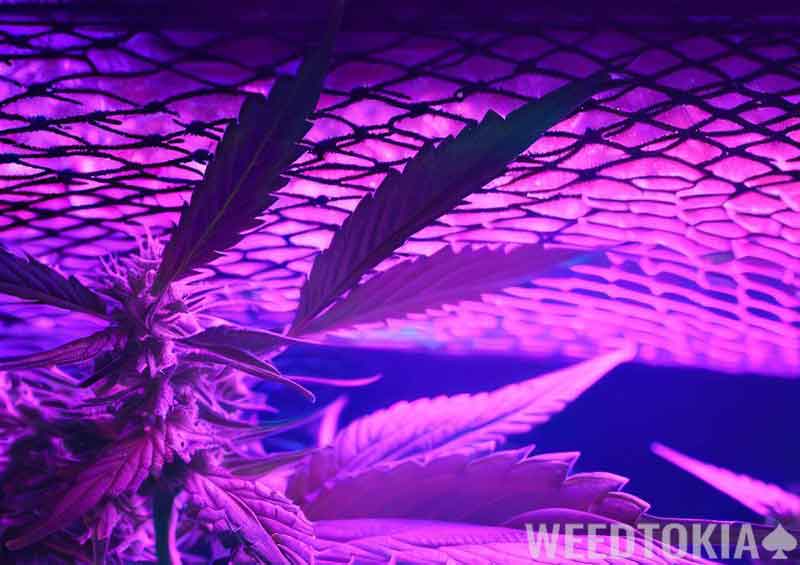
After defoliating is complete, the next step is installing netting or trellis to the canopy for added support. At weeks 3-4, most cultivars will be 2-3 feet tall. Install the trellis so it’s about 2 inches above the canopy line.
During elongation in the flowering stage, you can slowly raise the trellis to ensure it is supporting the plant about 4-6 inches down from the cola structures. This fortifies the heaviest parts of the limbs with added support, especially in late flower once the bud structure is fully developed. Installing trellis after the initial prune and defoliation makes the process easier as working around it can be tricky later on.
The Flowering Stage
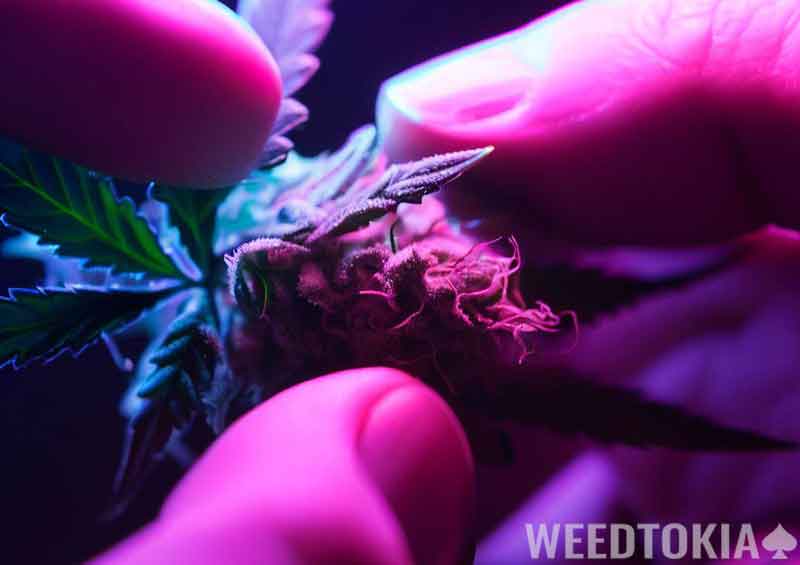
Depending on plant growth rates and morphology, you will be ready to switch the light cycle to flower (12 hours of light, 12 hours of darkness) once plants are 1.5-2 feet tall. By the end of week 1 in flower, you will need to inspect the canopy again for any additional fan leaves that are hanging over your growth points. This is also the best time to remove any additional branching or new growth that may compromise the 3-5 established growth points. On each established stem, you only require 2-3 axillary growth points (including the top point) at the last 4 inches of the stem.
From weeks 2-3 in flower, you’ll need to continue to monitor the canopy and again remove large fan leaves that are blocking the bud sites. You will also need to top any growth points again that may be causing inconsistent heights in the canopy. At this time, you can defoliate aggressively to further force the desired limb structure and apply some LST (Low Stress Training) to the plants.
This will likely need to be performed again at weeks 4-5, depending on development. However, it is important not to strip plants bare throughout the entire flower cycle and allow time for plants to regenerate fan leaves until week 5. This balance maintains proper transpiration rates, photosynthesis, and translocation of mobile nutrients to primary growth points.
Finally, at week 4-5, it’s time to perform the final defoliation of fan leaves. You can also raise the trellis as needed and “weave” limbs through the trellis to separate limbs that may be growing too closely together in the canopy. This helps create further circulation and light penetration while adding an additional level of control over the consistency of your canopy height.
By now, you should have a consistent canopy, and elongation of stems will halt—you can now observe the colas and terminal buds on each stem. Because vegetative growth is slowing at this time, defoliation must be executed carefully to ensure enough foliage is left for proper flower production and photosynthesis until harvest.
All fan leaves protruding from the center stalk should be completely removed, as well as leaves hanging over any buds or colas. It’s important to still maintain some small fan leaves at the top of each cola (around 2-3) for additional transpiration.
Preparing For Harvest
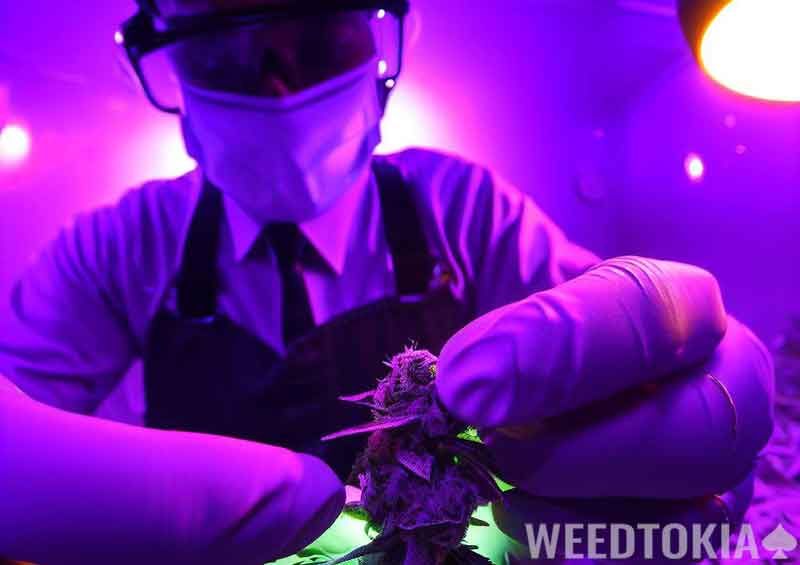
One week before harvest, you can completely remove all fan leaves, prepare for harvest, allow full light penetration, and induce a bit more stress. Along with dropping grow-room humidity and temperature, this will also reduce the risk of bud rot by maximizing air circulation to the largest bud sites and colas. Full light penetration of your equal SOG canopy will create a consistent harvest in bud size, potency, and density.
What Size Yields Can You Expect Using SOG?
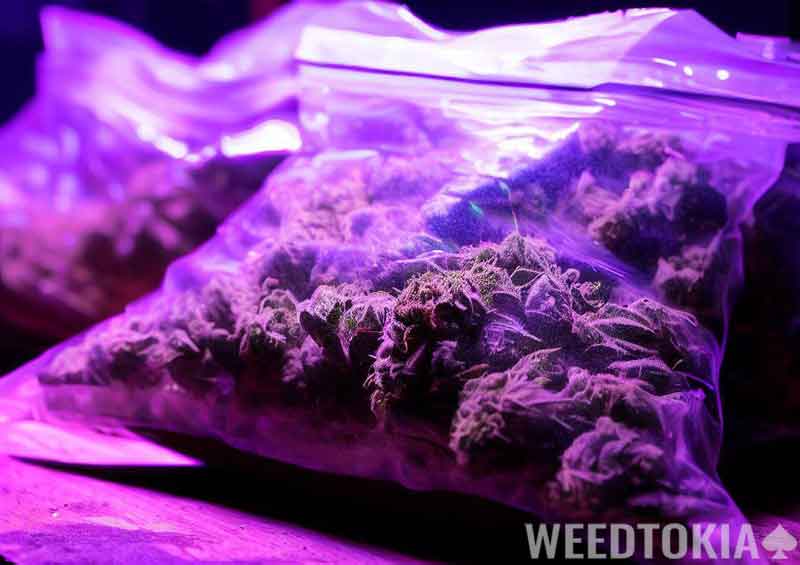
Yields vary due to a variety of factors: cultivar growth habit, environmental parameters, diseases, and pathogens (present or not), nutrient applications, and watering frequencies are all examples of inputs that affect yield beyond pruning and growth manipulation.
Assuming all inputs are applied properly throughout the growth cycle in a pathogen-free environment, you can expect roughly 50-75g/plant with the SOG method. Moisture content after drying and bud density at harvest play a large role in the overall final yield.
Large “airy” buds may appear impressive at harvest but may lose up to 90% of their weight once dried and trimmed. Medium-sized golf ball-like buds with a dense form usually weigh in the best, even though they may appear smaller than other strains at harvest. Light intensity, air circulation, light spectrum, and amount of light also play a large factor in the final result.
Wrap Up:
That does if for this article. If you have any questions about the SOG method, let us know in the comments section below.